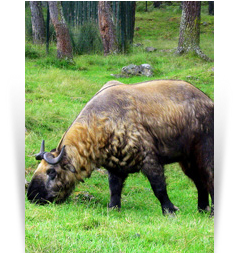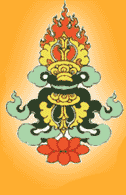About Bhutan
Bhutan is the last of the small, hidden kingdoms in the Himalayas to unlock the doors to its mysteries. The Land of the Thunder Dragon, as its original name implies, has maintained its integrity and independence throughout the centuries, repelling invasions from the strongholds of its fortified monasteries, or "dzongs". Bhutan's 38,394 square kilometers are almost entirely mountainous, with the land rising from approximately 180 meters above sea level in the south to the over 7,000 meter snow peaks in the north. The higher regions of these mountains remain almost entirely free of the footprint of man, while the world of alpine meadows below belongs to the yak herders who bring up their herds for grazing amidst the rich grasslands and fields of wildflowers.
Bhutan is a land locked country, approximately 300 km from east to west and 150 km from north to south. It is situated along the southern slopes of the Himalayan range between the latitudes of 26 degrees 30’ North and 28 degrees 10’ North, and longitudes of 88 degrees 45’
Bhutan is the last of the small, hidden kingdoms in the Himalayas to unlock the doors to its mysteries. The Land of the Thunder Dragon, as its original name implies, has maintained its integrity and independence throughout the centuries, repelling invasions from the strongholds of its fortified monasteries, or "dzongs". Bhutan's 38,394 square kilometers are almost entirely mountainous, with the land rising from approximately 180 meters above sea level in the south to the over 7,000 meter snow peaks in the north. The higher regions of these mountains remain almost entirely free of the footprint of man, while the world of alpine meadows below belongs to the yak herders who bring up their herds for grazing amidst the rich grasslands and fields of wildflowers.
Bhutan is a land locked country, approximately 300 km from east to west and 150 km from north to south. It is situated along the southern slopes of the Himalayan range between the latitudes of 26 degrees 30’ North and 28 degrees 10’ North, and longitudes of 88 degrees 45’
East to 92 degrees 25’ East. It is bounded by Tsang and Lho-Bag provinces of the Tibetan Autonomous Region of China in the north and north west, and the Indian states of Sikkim, West Bengal, Assam and Arunachal Pradesh in the west, south and east.
The flora and fauna of Bhutan represents the most unspoiled example in the world today of the fast-disappearing Himalayan ecology. Brilliantly colored birds and butterflies are everywhere, along with endless species of flowers, whole mountain slopes covered with tree-size rhododendrons, including some of the rarest species in the Himalayas.
The people of Bhutan can be broadly divided into three main ethnic groups, though this distinction is becoming blurred due to inter-marriages taking place in modern times. The “Sharchops”, who live in the east of the country are believed to be the original inhabitants. The “Ngalongs”, who live mostly in western Bhutan, are the descendants of Tibetan immigrants who arrived in Bhutan from the 9th century. The “Lhotshampa”, who are of Nepalese origin, settled in the south of Bhutan in the late 19th century. The latter (“Lhotshampa” meaning Southern Bhutanese) are mostly Nepali speaking.
The Bhutanese architectural landscape is made up of chortens (stupas), stonewalls, temples, monasteries, fortresses, mansions and houses.
Bhutan is a remote, mysterious, exhilarating place to visit. It is the most unspoiled, beautiful, powerfully traditional country in the Himalayas, and possibly on earth. Over 72 per cent of the country is under forest cover, including 26 per cent categorized as protected areas, consisting of four national parks. Its allure has attracted visitors from far away places since the 17th century due to its pure and genuine cultural heritage. The merger of past and future is very visible in Bhutan. Thus, travel to Bhutan can be a gift of beauty, insight, and friendship to be treasured for a lifetime.
Please come with an open mind. You are not coming to an ordinary place!
Facts and Figures
Area: 38, 394 Sq/Km
Altitude: Varying from 180m to 7,550m above sea level
Inhabitants: 737,182 (Population and Housing Census, 2005)
Life expectancy at birth: 68.9 Years (2005)
Capital: Thimphu
International Airport: Paro, 60 km from Thimphu (Just an hour’s drive)
Language: official language “Dzongkha”, English widely spoken
Religion: Vajrayana stream of Mahayana Buddhism (Also known as Tantric Buddhism)
Local time: Six hours ahead of GMT
Currency: Ngultrum (at par with the Indian Rupee)
Forest Cover: - 72%.
Agricultural area: - 7.8%
National Game: Traditional Archery
National Animal: Takin - Bodorcas taxi color
National Flower: Blue Poppy, Meconopis granis
National Tree: Tsenden, Himalyalca cypress.
National Bird: Raven, Coruas coraxs
The flora and fauna of Bhutan represents the most unspoiled example in the world today of the fast-disappearing Himalayan ecology. Brilliantly colored birds and butterflies are everywhere, along with endless species of flowers, whole mountain slopes covered with tree-size rhododendrons, including some of the rarest species in the Himalayas.
The people of Bhutan can be broadly divided into three main ethnic groups, though this distinction is becoming blurred due to inter-marriages taking place in modern times. The “Sharchops”, who live in the east of the country are believed to be the original inhabitants. The “Ngalongs”, who live mostly in western Bhutan, are the descendants of Tibetan immigrants who arrived in Bhutan from the 9th century. The “Lhotshampa”, who are of Nepalese origin, settled in the south of Bhutan in the late 19th century. The latter (“Lhotshampa” meaning Southern Bhutanese) are mostly Nepali speaking.
The Bhutanese architectural landscape is made up of chortens (stupas), stonewalls, temples, monasteries, fortresses, mansions and houses.
Bhutan is a remote, mysterious, exhilarating place to visit. It is the most unspoiled, beautiful, powerfully traditional country in the Himalayas, and possibly on earth. Over 72 per cent of the country is under forest cover, including 26 per cent categorized as protected areas, consisting of four national parks. Its allure has attracted visitors from far away places since the 17th century due to its pure and genuine cultural heritage. The merger of past and future is very visible in Bhutan. Thus, travel to Bhutan can be a gift of beauty, insight, and friendship to be treasured for a lifetime.
Please come with an open mind. You are not coming to an ordinary place!
Facts and Figures
Area: 38, 394 Sq/Km
Altitude: Varying from 180m to 7,550m above sea level
Inhabitants: 737,182 (Population and Housing Census, 2005)
Life expectancy at birth: 68.9 Years (2005)
Capital: Thimphu
International Airport: Paro, 60 km from Thimphu (Just an hour’s drive)
Language: official language “Dzongkha”, English widely spoken
Religion: Vajrayana stream of Mahayana Buddhism (Also known as Tantric Buddhism)
Local time: Six hours ahead of GMT
Currency: Ngultrum (at par with the Indian Rupee)
Forest Cover: - 72%.
Agricultural area: - 7.8%
National Game: Traditional Archery
National Animal: Takin - Bodorcas taxi color
National Flower: Blue Poppy, Meconopis granis
National Tree: Tsenden, Himalyalca cypress.
National Bird: Raven, Coruas coraxs






Tel: +975 2 326 266
Fax: +975 2 326 689
E-mail: tsewangnidup@yahoo.com
Fax: +975 2 326 689
E-mail: tsewangnidup@yahoo.com